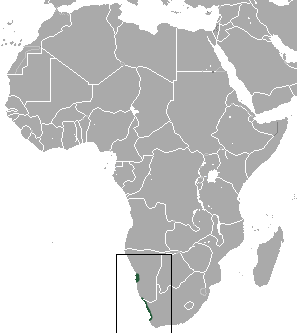Grant's golden mole facts for kids
Quick facts for kids Grant's golden mole |
|
|---|---|
 |
|
| Conservation status | |
| Scientific classification | |
| Genus: |
Eremitalpa
|
| Species: |
granti
|
| Subspecies | |
|
E. g. granti |
|
 |
|
| Grant's golden mole range | |
The Grant's golden mole (scientific name: Eremitalpa granti) is a special type of golden mole. People sometimes call it the dune shark because of how it moves! It is the only animal in its group, which is called Eremitalpa.
What Does It Look Like?
Like all golden moles, the Grant's golden mole is built for digging. It looks a bit like a regular mole, but they are not closely related. Their front paws are like strong digging claws. Unlike most other golden moles, they have three claws on each front paw.
These moles have no tail that you can see. They also don't have ears that stick out. Their eyes are covered with fur, so they can't see very well. They have a tough, leathery pad on their nose. This pad helps them dig through the sand.
Grant's golden moles have long, soft fur. Young moles have gray fur. Older moles have sandy-colored fur, which helps them blend in with their desert home. They are quite small! They grow to be about 7.5 to 9 centimeters long. They weigh only about 15 to 25 grams. This makes them the smallest golden mole species.
Where Do They Live?
Grant's golden moles live along the western coast of South Africa. They also live in the southwestern part of Namibia. Their natural home is in dry areas, especially sandy deserts.
How Do They Live and What Do They Eat?
Unlike many other golden moles, Grant's golden moles usually don't build long-lasting tunnels. Instead, they "swim" through the sand. They move just under or right on the surface while looking for food.
These moles are mostly active at night. During the day, they rest in small caves. They often hide under plants to stay safe. Grant's golden moles are lonely animals. This means they live by themselves. Each mole has its own area, which is about 4.6 hectares big.
When they hunt at night, they move in different ways. They might move over the sand surface. They also dip their heads into the sand. This helps them feel tiny vibrations in the ground. Then, they "swim" through the sand to find their prey.
Their main food is termites. But they also eat other small invertebrates (animals without backbones). Sometimes, they even eat small reptiles, like skinks.


